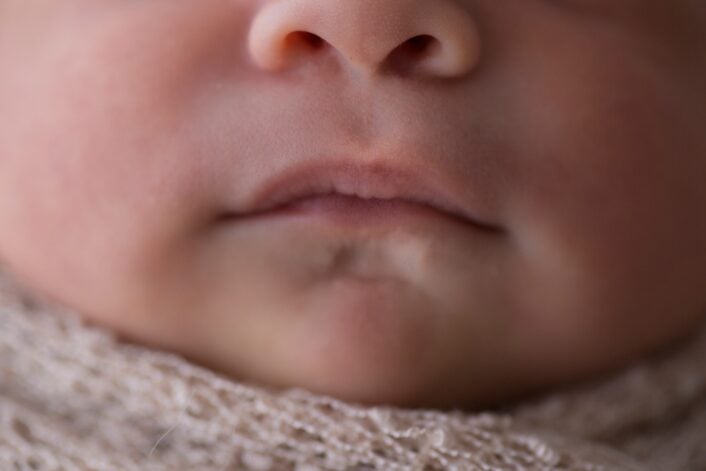

Disclaimer: This article is for informational purposes only and is not intended to diagnose any conditions. LifeDNA does not provide diagnostic services for any conditions mentioned in this or any other article.
Have you ever wondered why some people have that distinctive Y-shaped dimple in the middle of their chin called a cleft chin and others don’t? The answer comes down to genetics.
About a month into a baby’s growth in the womb, the chin starts forming. Usually, the two sides come together smoothly, but sometimes they don’t, leaving a gap or “cleft.” This distinctive trait happens before birth when the jaw’s sides don’t fully join. Despite its look, a cleft chin typically doesn’t cause serious health issues.
However, it raises questions about how they’re formed and how they might indicate underlying genetic patterns relevant to other health conditions. Understanding the inheritance of cleft chins is important for those seeking insights into one’s genetic makeup and potentially also their well-being
A cleft chin, also known as a dimpled chin, is a distinctive facial feature characterized by a small indentation or crease in the center of the chin. This characteristic trait develops during fetal growth, as the lower jawbones form and come together in the middle of the chin. However, in some cases, variations in the fusion of these jawbones result in a gap in the formation, hence the cleft chin.
The development and appearance of a cleft chin can vary from person to person. It may be influenced by a combination of genetic and lifestyle factors that can affect the prominence of the dimple. With weight gain, it can often become more noticeable whereas weight loss can reduce its visibility.
Yes, a cleft chin is influenced by genetics, but it’s not as straightforward as once believed. Initially, it was thought that a cleft chin was a dominant trait determined by a single gene. However, we now understand that chin shape is affected by multiple genes, making it impossible to predict accurately using simple Punnett squares.
A Punnett square is a tool chart used to predict the likely distribution of genotypes in the offspring of two parents. When applied to cleft chins, it demonstrated the probability of an offspring inheriting a cleft chin or a smooth chin from their parents.
Understanding how cleft chins are inherited involves the complexity of genetics as researchers like John H. McDonald of the University of Delaware concluded. We now know that each individual inherits two copies of every gene, one from a mother and one from a father. Variation in genes is presented by different versions known as alleles. In the case of cleft chins, when simplified, there are at least two alleles: one for a cleft chin and one for a smooth chin. The cleft chin allele is dominant, meaning it usually manifests itself even if only one copy is inherited, while the smooth chin allele is recessive and requires two copies to be expressed.
So, if an individual has a cleft chin, they may have inherited two dominant alleles or one dominant and one recessive allele. This genetic combination influences the likelihood of passing the cleft chin trait to their offspring. Family studies have shown that even parents with smooth chins can have children with cleft chins, indicating the complexity of the actual inheritance patterns.
While early genetic theories suggested that a single dominant gene controlled cleft chin inheritance, recent research by Bhanu and Malhotra has revealed a more nuanced picture. Their studies demonstrated significant variation in cleft chin occurrence among different populations and genders, with factors like age also playing a role. Furthermore, John H. McDonald’s research at the University of Delaware debunked the idea of a simple dominant-recessive trait, highlighting the involvement of multiple genes and environmental factors such as aging in shaping the chin.
Instead of a simple dominant model, many genes work together to determine chin shape, resulting in a wide range of chin types. For example, in early studies, Guenther (1939) found 9 cases in 5 generations, and von Meirowsky (1924) reported 25 cases in 4 generations. Gorlin (1982) noted it in 4 generations, and McKusick (1988) found it in 3 generations. McKusick (1992) stated that a publishing colleague of his, who had this trait, was in the third generation of affected males in his family. In general, females appear to be less conspicuously affected than males. Family studies have shown that having a cleft chin is not just about having strong “cleft” alleles—sometimes even parents with smooth chins have kids with cleft chins.
Research by Bhanu and Malhotra (1972), shows that there’s significant variation in the occurrence of cleft chins among different groups and genders. For example, the data showed that 4% to 71% of Indian populations had cleft chins and that German males possessed them with greater frequency than their female counterparts. Moreover, they discovered that as age progresses, so does the likelihood of a cleft chin becoming more prominent. This, therefore shows the intricate nature of cleft chin inheritance, its appearance, and the need for a comprehensive understanding of genetic and environmental influences on facial traits.
A cleft chin is permanent, as it is a physical characteristic determined by genetics and the structure of the jawbone. While there are some nonsurgical and surgical procedures that can alter the appearance of a cleft chin, these are not always permanent solutions and may carry risks or complications. It is advisable to consult a professional for personalized advice.
Age-related eyelid sagging is generally a permanent condition due to the natural aging process. While the condition itself is permanent, there are effective treatments available to address and manage eyelid sagging.
Non-surgical options include the use of skin-firming creams and treatments that can temporarily tighten the skin around the eyes. For a more long-lasting solution, surgical procedures like blepharoplasty can remove excess skin and tighten the muscles, significantly improving the appearance of sagging eyelids.
While cleft chins are generally considered a harmless genetic trait, their presence can sometimes indicate underlying genetic patterns that might be relevant for other wellness conditions. Here are a few considerations:
For individuals concerned about the appearance of their cleft chin, there are both non-surgical and surgical procedures available to address this trait. Non-surgical procedures offer temporary solutions by reducing the visibility of a cleft chin and requiring regular maintenance to sustain the desired outcome.
On the other hand, surgical options provide more permanent alterations to the chin’s appearance. While these surgical procedures offer long-lasting results, they also come with potential risks and complications, such as infection, bleeding, or dissatisfaction with the aesthetic outcome. Therefore, individuals considering surgical options should consult with a qualified healthcare provider to thoroughly understand the associated risks and benefits before proceeding with this type of treatment.
For individuals seeking non-surgical procedures, these options focus on enhancing chin contours and reducing the appearance of the cleft through minimally invasive techniques.
These procedures involve more permanent solutions for reshaping the chin structure to remove the cleft and achieve the desired outcomes.
*Understanding your genetics can offer valuable insights into your well-being, but it is not deterministic. Your traits can be influenced by the complex interplay involving nature, lifestyle, family history, and others.
Our reports and suggestions do not diagnose or treat any health conditions or provide any medical advice. Consult with a healthcare professional before making any major lifestyle changes or if you have any other concerns about your results.


